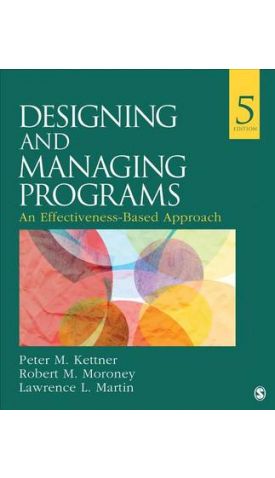אנו משתמשים ב-Cookies כדי לשפר את החוויה שלך. כדי לקיים ההנחיה החדשה של e-Privacy, עלינו לבקש את הסכמתך להגדיר את ה-Cookies. קבלת מידע נוסף.
433.00 ₪
DESIGNING & MANAGING PROGRAMS 5e
433.00 ₪
ISBN13
9781483388304
יצא לאור ב
Thousand Oaks
מהדורה
5
זמן אספקה
21 ימי עסקים
עמודים
288
פורמט
Paperback / softback
תאריך יציאה לאור
1 באפר׳ 2016
מחליף את פריט
9781412995160
שם סדרה
SAGE Sourcebooks for the Human Services
Authors Peter M. Kettner, Robert M. Moroney, and Lawrence L. Martin, all leaders in the field, incorporate the principles of effectiveness-based planning as they address the steps of designing, implementing, and evaluating a human services program at the local agency level.
The Fifth Edition of the classic Designing and Managing Programs for human services helps readers grasp the meaning and significance of measuring performance and evaluating outcomes. The authors, all leaders in the field, incorporate the principles of effectiveness-based planning as they address the steps of designing, implementing, and evaluating a human services program at the local agency level.
| מהדורה | 5 |
|---|---|
| עמודים | 288 |
| מחליף את פריט | 9781412995160 |
| פורמט | Paperback / softback |
| ISBN10 | 1483388301 |
| יצא לאור ב | Thousand Oaks |
| תאריך יציאה לאור | 1 באפר׳ 2016 |
| תוכן עניינים | Part I: Assessing Current Practices Chapter 1: Contemporary Issues in Human Service Program Planning and Administration The Era of Accountability The Logic Model Community Focus The Issue of Effectiveness Assessing an Existing Program What Is Effectiveness-Based Program Planning? Using Effectiveness Principles to Understand Existing Programs Implementation Considerations Part II: Problem Analysis/Needs Assessment Chapter 2: The Contribution of Theory to Program Planning The Use of Theory in Program Planning Theory in Practice Planning Theory Types of Planning Theory in Program Planning Chapter 3: Understanding Social Problems Addressing Social Problems Stating Problems as Solutions The Need for a New Approach Identifying a Social Condition Defining Problems Frameworks for Production Analysis Chapter 4: Needs Assessment: Theoretical Considerations The Concept of Need Theoretical understandings of Need Needs Assessment and the Planning Process Factors Influencing the Definition of Need Different Perspectives on Need Factors Influencing the Definition of Need Different Perspectives on Need Need Categories and the Planning Process Determining Who Is in Need Two Major Problems: Reliability and Availability of Data Chapter 5: Needs Assessment: Approaches to Measurement Methodologies Used in Measuring Need Extrapolating from Existing Studies: Normative Need Using Resource Inventories: Normative Need Using Service Statistics: Expressed Need Conducting a Social Survey: Perceived Need Holding a Public Forum: Perceived Need Focus Groups Selecting the Best Method Approaches Useful for Locating Concentrations of High-Risk Groups Part III: Planning, Designing, and Tracking the Intervention Chapter 6: Selecting the Appropriate Intervention Strategy The Program Hypothesis Types of Program Hypotheses The Process of Developing a Program Hypothesis Program Hypotheses and the Idea of Consequences From Program Hypothesis to Service Benefits of the Program Hypothesis Chapter 7: Setting Goals and Objectives From Program Hypothesis to Goals and Objectives The Function of a Mission Statement Goals and Objectives: A Framework for Action Agency Example: Safe Haven The Formulation of Goals The Formulation of Objectives Requirements for All Objectives Outcome Objectives Process Objectives and Activities Integrating Outcome Objectives, Process Objectives, and Activities Chapter 8: Designing Effective Programs The Significance of Program Design Program Design and Diversity Defining the Elements of a Program The Relationship between Objectives and System Components Specifying the Program Hypothesis Chapter 9: Designing Effectiveness-Based Information Systems Documentation Practices in Human Services Designing a Data Collection System for a Program Part IV: Calculating the Value and Cost of the Intervention Chapter 10: Performance Measurement, Monitoring, and Program Evaluation The Link between Performance Measurement, Monitoring, and Evaluation and Management Information Systems Feedback and Self-Evaluating Systems Performance Measurment Monitoring Program Evaluations Program Data Requirements Performance Measurement, Monitoring, Program Evaluation, and Program Data The Utility of Performance Measurement, Monitoring, and Program Evaluation Chapter 11: Impact Program Evaluation and Hypothesis Testing Differentiating Impact Program Evaluation from Performance Measurement Impact Program Evaluation Impact Program Evaluation and Hypothesis Testing Research Design for Impact Program Evaluation Nonequivalent Comparison Group Design Chapter 12: Budgeting for Financial Control, Management, and Planning The Differences between Budgeting and Accounting The Principal Purposes and Budgeting Budgeting and the Systems Framework Major Models of the Budgetary Process Major Budgeting Systems Dealing with Revenue Increases and Decreases Budgeting in Human Service Agencies and Programs Today Chapter 13: Developing Line-Item, Functional, and Program Budgeting Systems Developing Line-Item Budgeting Systems The Link between Line-Item, Functional, and Program Budgeting Systems Fucntional Budgeting Systems Program Budgeting Systems A Comprehensive Budgeting System |
| זמן אספקה | 21 ימי עסקים |



Login and Registration Form